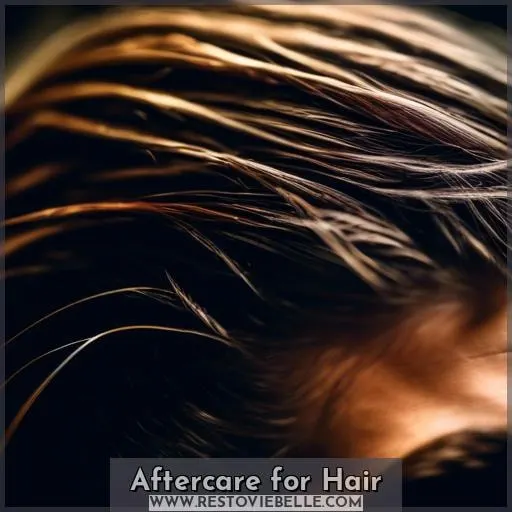This site is supported by our readers. We may earn a commission, at no cost to you, if you purchase through links.
 Struggling with tree sap in your hair can be a real bind, but don’t worry—you’re not stuck with it.
Struggling with tree sap in your hair can be a real bind, but don’t worry—you’re not stuck with it.
Whether it’s a dollop of pine sap that’s turned your locks into a sticky mess or a subtle smear that’s just as stubborn, there’s a way out.
From kitchen staples like oils and peanut butter to household items like mayonnaise, these tried-and-true methods will help you dissolve that gummy nuisance.
So, roll up your sleeves and get ready to reclaim your hair’s freedom and shine with our comprehensive guide on how to get sap out of hair.
To remove sap from hair, applying peanut butter and then washing it out with water can effectively dissolve the sap. Alternatively, using oils like olive or baby oil can help break up the sap, which can then be combed out gently.
Table Of Contents
- Key Takeaways
- Understanding Tree Sap and Hair
- Effective Sap Removal Methods
- Step-by-Step Removal Process
- Aftercare for Hair
- Frequently Asked Questions (FAQs)
- Can certain types of tree sap cause allergic reactions when trying to remove them from hair?
- How can environmental factors, like humidity or temperature, affect the process of removing sap from hair?
- Are there any hair types or textures that are more susceptible to damage during the sap removal process?
- What are the long-term effects of frequently getting sap in hair, and how can one protect their hair from these effects?
- Can dietary changes or supplements help in strengthening hair against the stickiness and potential damage caused by tree sap?
- Conclusion
Key Takeaways
- Oils such as olive, baby, and vegetable oil can break down sap, making it easier to remove from hair.
- Household items like mayonnaise, which contains natural conditioners, and dish soap can also be effective in sap removal.
- Patience and a gentle approach are crucial when removing sap to avoid damaging the hair.
- If sap proves difficult to remove, professional help may be necessary.
Understanding Tree Sap and Hair
Understanding the characteristics of pine sap and the precautions needed for its removal is crucial when dealing with this sticky substance in hair.
Pine sap is similar to gum in its ability to dry and harden on hair, making it a challenging mess to remove, especially when it forms large globs.
It’s essential to approach the removal process with patience and care, using the right products and techniques to avoid damaging the hair or skin.
Characteristics of Pine Sap
When dealing with pine sap in your hair, understanding its characteristics can help you remove it effectively and safely.
- Sap Consistency: Pine sap is sticky and can harden over time, making it challenging to remove from hair.
- Clump Size: The size of the sap clump affects the removal method. Small clumps may be easier to remove when dry, while larger globs might require breaking up before treatment.
- Hair Type: Different hair types may respond differently to sap removal methods. Curly or textured hair might need a gentler approach.
- Application Time: Allowing removal agents like oils to sit for an adequate time is crucial for effective sap removal.
Always exercise Safety Precautions to protect your hair and skin. Be patient and persistent, and consider seeking professional help if needed.
Precautions for Sap Removal
When dealing with the removal of sap from hair, it’s crucial to approach the situation with care to avoid causing damage to your hair or scalp.
-
Hair sensitivity: Your hair and scalp can be sensitive to various substances. Before applying any removal agent, especially chemical alternatives like alcohol or acetone, test a small amount on a less visible section of your hair or skin to ensure there’s no adverse reaction.
-
Removal assistance: Don’t hesitate to ask for help, especially when dealing with hard-to-reach areas or if you’re finding the process challenging. An extra pair of hands can make the removal process more efficient and less frustrating.
-
Time-saving techniques: While it might be tempting to rush the removal process, especially if you’re in a hurry, taking your time is essential. Rushing can lead to hair damage or incomplete removal of the sap. Patience is key, and allowing oils (like olive oil or baby oil) to soak into the sap for an extended period can significantly ease the removal process.
Effective Sap Removal Methods
When it comes to removing sap from hair, various household items and oils can be effective solutions. Oils such as olive oil, baby oil, and even cooking oils like vegetable oil can break down the sap, making it easier to comb out of the hair.
The process involves applying the oil to the sap-affected area, allowing it to soak in to break down the sap, and then gently trying to remove the sap with your fingers or a comb, taking care not to damage the hair shafts.
Afterward, washing the hair with regular shampoo should remove any remaining sap.
For more stubborn sap, products like mayonnaise, which contains natural conditioners, can also be effective. Applying mayonnaise directly to the sap and allowing it to sit for about fifteen minutes before washing it out with shampoo can’t only help remove the sap but also leave the hair well-nourished and smooth.
In addition to oils and mayonnaise, other substances like dish soap, particularly degreasing types like Dawn dishwashing liquid, can be effective at removing sap from hair. These soaps are designed to tackle tough grease and can work well on sticky substances like sap.
Applying the soap directly to the sappy area, wetting the section, and then washing it out can help remove the sap.
It’s important to be patient and gentle during the removal process to avoid damaging the hair. In some cases, especially with larger or more stubborn sap clumps, it might be necessary to repeat the application of these products or combine methods for effective removal.
After the sap is removed, it’s recommended to shampoo and condition the hair as usual to ensure all residues from the removal products are washed out and the hair is left clean and hydrated.
For those dealing with sap in sensitive areas like armpit hair, the same techniques can be applied, but extra care should be taken due to the sensitivity of the skin in these areas.
Oils and Fats
Moving from understanding the sticky dilemma of tree sap in your hair, let’s dive into the role of oils and fats in the sap removal process. These natural remedies aren’t just your kitchen staples but also your first line of defense against the clingy sap.
- Oily Residue: Oils like olive, coconut, and vegetable oil create an oily residue that weakens the sap’s grip on your hair, making it easier to comb out.
- Hair Damage Prevention: Unlike harsh chemicals, these oils minimize hair damage during the removal process. Their natural composition nourishes your hair, preventing breakage.
- Product Absorption: The oil penetrates the sap, facilitating easier removal. For thick sap, baby oil acts as a powerful agent, softening the sap for mechanical removal without harming your hair.
Alternative oils such as honey, peanut butter, and mineral oil not only offer a variety of options based on what you have at hand but also ensure that the removal process is gentle on your hair.
Household Items
Moving from the previous discussion on using oils and fats to remove sap from hair, let’s explore some common household items that can also be effective.
- Detergent and Soap: Dish soap or a mild hand detergent can cut through the sap’s stickiness, especially when combined with a bit of elbow grease.
- Alcohol-Based Products: Rubbing alcohol, hand sanitizer, or alcohol-based wipes can break down the sap, making it easier to comb out.
- Nail Polish Remover: For particularly stubborn sap, acetone-based nail polish remover can be used, but be cautious of its drying effects and avoid contact with the eyes.
Step-by-Step Removal Process
When dealing with the sticky situation of tree sap in your hair, it’s important to approach the removal process with the right techniques and products. You’ll want to soften the sap first, which can be done using various oils such as baby oil, olive oil, or even peanut butter, as these substances can loosen the sap’s grip on your hair.
Once the sap is softened, applying a removal agent and using a mechanical method, like combing, will help extract the sap from your strands.
To start, you’ll need to select an oil-based product or another recommended substance like mayonnaise or alcohol, depending on what you have available. Apply your chosen product to the affected area, ensuring that you cover the sap thoroughly.
Next, gently work the product into the sap-covered area with your fingers or a washcloth, breaking up any clumps as you go. For certain products, such as baking soda or pine oil, it may be beneficial to let them sit on the affected area for a few minutes to penetrate the sap more effectively.
Finally, use a comb to carefully remove the sap from your hair. A wide-toothed comb is recommended to avoid pulling or damaging your hair. If you encounter any particularly stubborn clumps, you may need to apply more product and continue working it in before attempting to comb through again.
Remember to be patient and gentle throughout the process to avoid damaging your hair. If the sap is proving difficult to remove, or if you’re concerned about causing harm to your hair, seeking professional help from a hair care specialist might be the best course of action.
Softening the Sap
To effectively soften tree sap in hair, a gentle and patient approach is crucial to avoid hair damage, scalp irritation, or hair loss.
-
Apply Heat Gently: Use a hair dryer on a low heat setting to carefully warm the sap. This helps in loosening its grip on your hair strands, making it easier to work with the removal agents.
-
Choose the Right Product: Opt for mayonnaise or baby oil for their oil content, which breaks down the sap without harsh chemicals. These options are safer for your scalp and hair, minimizing the risk of irritation.
-
Patience is Key: Allow the chosen product to sit on the affected area for a few minutes. This patience is required to let the product penetrate and effectively dissolve the sap, facilitating easier removal.
Application of Removal Agents
To effectively apply removal agents to sap in your hair, you’ll want to follow these steps:
- Choose your agent: vegetable oil, mayonnaise, or peanut butter are great for breaking down the sap.
- Apply generously: pour or spoon your chosen product onto a washcloth or directly onto your hand.
- Work it in: rub the product into the sap-covered area, using your fingers to break up any clumps.
- Comb it out: after letting the product sit, use a comb to gently remove the sap from your hair.
Mechanical Removal
Once you’ve encountered the sticky situation of having sap in your hair, mechanical removal is a crucial step in the process.
- Break up the sap: If the sap has hardened, gently crush it with pliers, taking care not to pull your hair.
- Choose the right tool: Use a wide-toothed comb to carefully work through the hair, starting from the ends and moving upward to avoid breakage.
- Apply safety measures: Protect your hair with a cloth when crushing larger clumps to prevent damage.
- Consider hair type: Be mindful of your hair’s texture; finer hair may require a gentler approach than thicker strands.
- Be patient: Removing sap can be time-consuming, especially if you’re dealing with large or numerous clumps. Take your time to avoid cutting your hair.
Aftercare for Hair
After successfully removing sap from your hair, it’s crucial to thoroughly clean and condition the area to restore its health.
Warm water should be used to rinse out any remaining product, ensuring that all traces of sap are gone.
Follow up with a gentle shampoo and a nourishing conditioner to mitigate any dryness caused by the removal products, such as alcohol or acetone, which can be harsh on your hair.
Cleaning and Conditioning
After successfully removing sap from your hair, it’s crucial to follow up with proper cleaning and conditioning to restore your hair’s health and shine. This aftercare process is essential to ensure that your hair remains soft, manageable, and free from any residue left by the removal agents.
- Shampoo your hair thoroughly: Use a gentle shampoo to cleanse your hair. Consider shampoos like Pine Tar Shampoo from Grandpa Soap Co., which can help soothe and invigorate the scalp while removing any remaining sap residue.
- Apply a nourishing conditioner: After shampooing, use a high-quality conditioner to hydrate and repair your hair. Look for conditioner brands that offer deep moisturization and hair repair benefits.
- Consider a hair mask: For extra nourishment, apply a hair mask once a week. Hair mask benefits include deep conditioning, strengthening hair fibers, and restoring shine.
- Use a leave-in conditioner: A leave-in conditioner can provide ongoing hydration and make your hair easier to manage. It helps in detangling and adds an extra layer of protection against environmental damage.
- Be gentle with your hair: After treating your hair with removal agents and washing it, be gentle while combing and styling. Use a detangling comb like the Cricket Ultra Smooth Detangler Comb, which is infused with oils and keratin to minimize damage and breakage.
By following these steps, you can ensure that your hair recovers well from the sap removal process, retaining its health and vibrancy.
Special Considerations
After you’ve treated your hair for sap removal, it’s crucial to consider the aftercare to maintain the health and integrity of your hair.
- Recognize the sensitivity of hair types; armpit hair, for example, is more delicate than scalp hair.
- Exercise patience and persistence; removing sap, especially from large clumps, can be time-consuming.
- Before applying removal agents, consider breaking up large clumps with pliers to make the process easier.
- Explore alternative removal methods like olive oil, and don’t hesitate to seek professional assistance if needed.
Frequently Asked Questions (FAQs)
Can certain types of tree sap cause allergic reactions when trying to remove them from hair?
Yes, certain types of tree sap, like pine and spruce sap (rosin or colophony), can cause allergic reactions, including acute allergic contact dermatitis and difficulty breathing, when trying to remove them from hair.
How can environmental factors, like humidity or temperature, affect the process of removing sap from hair?
Environmental factors like humidity and temperature can turn the battle against sap in your hair into a sticky ordeal.
Imagine the sap as a stubborn squatter in your locks, with humidity acting as its ally, making it cling tighter, and heat transforming it into a more adhesive foe.
In this dance of elements, your patience and persistence become your greatest weapons. High humidity can make the sap more pliable but also more pervasive, while elevated temperatures can either soften it for easier removal or bake it onto your strands, depending on the removal method used.
Are there any hair types or textures that are more susceptible to damage during the sap removal process?
Curly and kinky hair types, with their intricate patterns and high density, are particularly vulnerable to damage during the sap removal process.
Their unique structure makes them more susceptible to breakage and dryness.
What are the long-term effects of frequently getting sap in hair, and how can one protect their hair from these effects?
Frequent sap exposure can dry out and damage your hair.
To protect it, use moisturizing shampoos and conditioners, avoid harsh chemicals, and consider deep conditioning treatments to maintain hair health.
Can dietary changes or supplements help in strengthening hair against the stickiness and potential damage caused by tree sap?
While a diet rich in essential nutrients can fortify your hair from the inside out, making it more resilient to environmental stressors like tree sap, there’s no magic diet that can specifically strengthen hair against the stickiness or potential damage caused by sap.
However, incorporating foods high in omega-3 fatty acids, vitamins B, C, D, and E, as well as minerals like zinc and iron, can overall improve hair health, making it stronger and potentially more resistant to damage.
Conclusion
Are you tired of the sticky situation that tree sap can cause in your hair? You’re not alone. With the right approach, you can effectively remove sap and restore your hair’s natural beauty.
Oils and fats like peanut butter or baby oil can soften and break down the sap, making it easier to comb out. After applying your chosen removal agent, gently work it through your hair, and follow up with a thorough wash.
Don’t forget to condition afterwards to replenish moisture and ensure your hair remains healthy and lustrous. Remember, patience is key in preserving your hair’s integrity while getting sap out.









